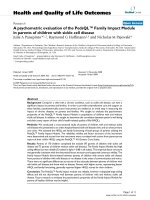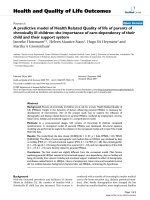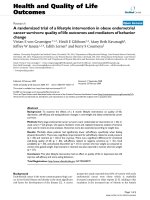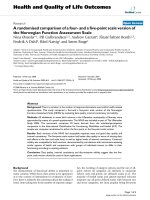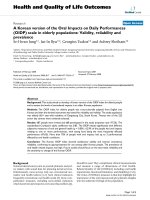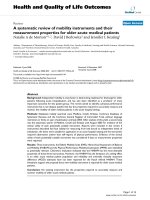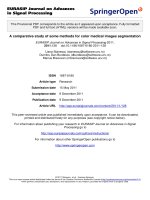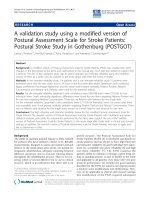báo cáo hóa học: " A prospective study of decline in lung function in relation to welding emissions" pdf
Bạn đang xem bản rút gọn của tài liệu. Xem và tải ngay bản đầy đủ của tài liệu tại đây (261.42 KB, 8 trang )
BioMed Central
Page 1 of 8
(page number not for citation purposes)
Journal of Occupational Medicine
and Toxicology
Open Access
Research
A prospective study of decline in lung function in relation to welding
emissions
Sigve W Christensen
1
, Jens Peter Bonde*
2
and Øyvind Omland
1,3
Address:
1
Department of Occupational Medicine, Aalborg Hospital, Århus University Hospital, Aalborg, Denmark,
2
Department of Occupational
Medicine, Århus Hospital, Århus University Hospital, Århus, Denmark and
3
Institute of Public Health, Dept. of Occupational and Environmental
Medicine, University of Århus, Århus, Denmark
Email: Sigve W Christensen - ; Jens Peter Bonde* - ; Øyvind Omland -
* Corresponding author
Abstract
Background: Numerous cross-sectional studies have reported reduced lung function among
welders but limitations of exposure assessment and design preclude causal inference. The aim of
this study was to investigate if long-term exposure to welding fume particulates accelerates the age-
related decline in lung function.
Methods: Lung function was measured by spirometry in 1987 and 2004 among 68 steel welders
and 32 non-welding production workers. The decline in forced expiratory volume (FEV
1
) was
analysed in relation to cumulated exposure to fume particulates among welders during the follow-
up period.
Results: Among smokers the decline in FEV
1
through follow-up period was in average 150 ml
larger among welders than non-welders while the difference was negligible among non-smokers.
The results did not reach statistical significance and within welders the decline in lung function was
not related to the cumulated welding particulate exposure during follow-up period
Conclusion: Long-term exposure to welding emissions may accelerate the age-related decline of
lung function but at exposure levels in the range of 1.5 to 6.5 mg/m
3
the average annual excess loss
of FEV
1
is unlikely to exceed 25 ml in smokers and 10 ml in non-smokers.
Introduction
Welding of metals may cause substantial exposure to
fume particulates and gases [1,2]. The main components
of welding emissions are oxides of metals due to contact
between the oxygen in the air and the vaporised metals.
The fume particulates and gases including ozone and
nitrogen oxides may cause inflammation and oxidative
damage to the airways [3,4]. Such processes are thought to
be closely linked to the pathogenesis of chronic obstruc-
tive pulmonary disease [COPD [5,6]]. It is well docu-
mented in clinical series that specific types of welding
operations as welding stainless steel may cause occupa-
tional asthma [7] and welding in general seems related to
a moderately increased risk of lung cancer [8]. However,
according to a recent review "incomplete information still
exists regarding the causality and possible underlying
mechanisms associated with welding fume inhalation
and pulmonary disease [9]."
Analyses of short term exposure to welding fumes and
gases have indicated an influence on lung function in
cross-shift studies [10-12] while others have not observed
Published: 26 February 2008
Journal of Occupational Medicine and Toxicology 2008, 3:6 doi:10.1186/1745-6673-3-6
Received: 14 August 2007
Accepted: 26 February 2008
This article is available from: />© 2008 Christensen et al; licensee BioMed Central Ltd.
This is an Open Access article distributed under the terms of the Creative Commons Attribution License ( />),
which permits unrestricted use, distribution, and reproduction in any medium, provided the original work is properly cited.
Journal of Occupational Medicine and Toxicology 2008, 3:6 />Page 2 of 8
(page number not for citation purposes)
such effects [13]. Data from population based studies [14-
16] and cross-sectional studies of working populations
[17-20] have indicated a long-term effect on lung function
from exposure to welding fumes and gases although the
evidence is not entirely consistent [21]. Others have sug-
gested an interaction between smoking and welding expo-
sure on the prevalence of pulmonary impairment [22].
Only few longitudinal studies in welding populations
have been published, and results have not been unambig-
uous [10,23,23,24]. In 2004 we re-examined the lung
function in a cohort of welders and blue-collar workers
examined in 1987 in a fertility study [25]. The longitudi-
nal analyses presented here take advantage of a compre-
hensive assessment of exposure to welding fume
particulates. The objective was to examine if exposure to
welding fume particulates is a risk factor for an accelerated
decline in lung function.
Methods
Study population
In 1987 the lung function was measured in 94 stainless
steel and mild steel welders and 49 manual workers that
were not exposed to welding emissions [25]. The latter
group consisting of turners, mechanics, electricians, and
unskilled labourers were all engaged at the same six work-
ing sites as the welders. Among the 143 participants from
the 1987 survey 4 were deceased and two were immi-
grated in 2004. The remaining 137 men were invited in
writing to participate in a follow-up study. Six declined
participation, thirty-one did not respond while 100
(69.9%) participated in the second survey [68 stainless
steel and mild steel welders (72.3%) and 32 non welders
(65.3%, Table 1)]. Demographic characteristics and
smoking habits in 1987 were slightly different among the
100 men that participated in the 2004 follow-up com-
pared to the 43 men that did not participate (Table 1).
Those not participating were younger, smoked less and
had a lower prevalence of respiratory disease. The Ethics
Committee of Health Science in Aalborg County, Den-
mark, approved the study and all participants gave their
written consent.
Questionnaire
We obtained comprehensive information on demo-
graphic variables, characteristics of welding work and
smoking habits for the period 1987 until 2004 by face-to
face interviews in 1987 and 2004 (Table 1). The same
questionnaire was used in 1987 and 2004, and the ques-
tions on respiratory diseases and symptoms were based
upon the modified British Medical Research Council
questionnaire [26]. Additional questions on history of
atopy were also asked. Atopy was defined by positive
answer to at least one of the three questions [27]: Have
Table 1: Characteristics of the study population.
Participants in follow-up Non-participants
Welders N = 68 Non-welders
1
N = 32 N = 43
Age at enrollment in 1987, years, mean (range) 33.2 (19–55) 34.9 (21–58) 30.8 (18–53)
Height, cm, mean (range) 178 (160–190) 179 (171–193)
Weight, kg, mean (range) 87.2 (65–124) 84.4 (70–125) .
Tobacco smoking, n (%)
Never-smoker 27 (40) 10 (31) 14 (33)
Ex-smoker in 1987 9 (13) 4 (13) 6 (14)
Current smoker in 1987 32 (47) 18 (56) 23 (53)
Current smoker in 2004 19 (28) 11 (34) .
Packyears
2
, mean (range)
Until 1987 13 (2–35) 12 (2–34) 8.0 (2.5–27)
1987–2004 11 (1–25) 8 (1–30) .
COPD, n (%)
3
9 (13) 2 (6) 1 (2)
History of atopy, n (%) 9 (13) 5 (16) .
Alfa-1-antitrypsin (serum), mg/dl, mean (range) 142 (90–220) 138 (70–210) .
Forced expiratory volume 1 sec (FEV
1
)
4
Liter/second, mean (range) 4.39 (3.0–5.8) 4.41 (3.3–6.0) 4.53 (3.0–6.0)
% of population average (range) 106 (82–126) 106 (82–130) 108.1 (88–138)
Forced expiratory capacity (FVC)
4
liter, mean (range) 5.39 (3.6–7.1) 5.54 (4.2–7.3) 5.55 (3.7–6.9)
% of population average (range) 107 (81–130) 108 (89–133) 109 (86–138)
1) A non-welder is defined as a blue-collar worker that did not perform welding operations during the follow-up period from 1987 through 2004.
2) Values given for smokers only. A pack includes 20 cigarettes or approximately 18 gram of tobacco.
3)Chronic obstructive lung disorder, FEV1/FVC < 0.70.
4) Spirometric measurements in 1987.
Journal of Occupational Medicine and Toxicology 2008, 3:6 />Page 3 of 8
(page number not for citation purposes)
you ever have had asthma? Have you ever have had any
kind of allergy to the nose, such as hay fever? Have you
ever have had eczema or some kind of skin allergy?
Welding exposure
A consecutive list of employments for all metalworkers
from primary school through 2004 was collected by inter-
view. For each employment we extracted information on
the first and last calendar year, the type of metal in which
the welding was performed (mild steel, stainless steel,
chromium alloyed steel and aluminum), welding method
[manual metal arc (MMA), metal active gas (MAG) and
tungsten inert gas (TIG)], welding intermittence (average
number of hours during a work shift), use of local exhaust
ventilation (yes/no/sometimes), and welding in confined
spaces (yes/no/sometimes). We reorganized the data to
obtain welding characteristics by decades (1950–59,
1960–69, 1970–79, 1980–89, 1990–99 and 2000–2004)
in order to estimate lifelong cumulated exposure to weld-
ing fume particulates based upon a large Danish welding
exposure database that provides ambient air particulate
concentration by decade, type of steel, welding method,
hours welding a day, exhaust ventilation and welding in
confined spaces. The exposure matrix include 364 cells
each providing the geometric mean exposure to welding
fume particulates for a specific welding process.
The welding exposure matrix is based upon 1.106 meas-
urements (786 MMA mild steel, 58 MMA stainless steel,
51 TIG stainless steel, and 152 MAG mild steel) of partic-
ulates in ambient air samples collected in filters placed in
the breathing zone behind the welding helmet [28]. The
measurements were performed in the Danish welding
industry from 1971 – 1985 by the Danish Welding Insti-
tute and the Danish Occupational Health Institute and are
considered to provide reliable and representative expo-
sure data. The database provides the geometric mean
value of the welding process specific particulate exposure
(mg/m
3
). The process specific exposures in decades before
1970 were estimated by extrapolation based upon the
declining trend of exposures that were observed from
1971 to 1985 for all types of welding processes. Very few
welding exposure measurements have been carried out in
Denmark since 1989. For purposes of the present expo-
sure assessment we assumed that the average exposure lev-
els have not changed from 1989 and onwards. However,
in an alternative approach we also estimated exposures in
1990–1999 and 2000–2004 based upon linear extrapola-
tion of exposures from 1971–85 and thus arriving at
lower exposure estimates.
Using the welding exposure matrix and the corresponding
interview data on decade, type of steel, welding method,
intermittence, exhaust ventilation, and welding in con-
fined spaces we computed the product of number of years
and particulate concentration in each decade and
summed over all decades to arrive at a summary measure
of total lifelong welding exposure (mg/m3*years), Table
2. No exposure data were available for welding of alloyed
steel at one plant. Estimates were based upon the corre-
sponding values for mild steel. Likewise, we used expo-
sure data for TIG stainless steel welding to estimate
exposure conferred by TIG welding on aluminum in six
welders. The exposure matrix does not account for
bystander and background exposure levels. This will result
in a disproportionately underestimation of exposure
Table 2: Distribution of estimated cumulative exposure to welding fume particulates by type of steel and main welding technology
among ever-welding Danish metal workers.
N Welders Years welding,
mean (STD)
Geometric mean
particulate exposure,
mg/m
3
Geometric mean (min-
max), mg/m
3
* years,
1950–2004
1
Geometric mean (min-
max), mg/m
3
* years,
1987–2004
1
Mild steel manual metal arc
(MMA)
37 7.5 (6.1) 4.1 31 (8–103) 17 (7–61)
metal active gas
(MAG)
39 12.4 (9.7) 3.2 40 (7–134) 26 (9–50)
Stainless steel manual metal arc
(MMA)
1 5.0 3.0 15 (15–15) 0
tungsten inert gas
(TIG)
28 15.1 (10.9) 1.4 22 (3–63) 14 (3–26)
Alloyed steel manual metal arc
(MMA)
20 16 (12.4) 6.5 105 (8–478) 42 (7–166)
tungsten inert gas
(TIG)
13 11.6 (7.6) 1,5 17 (2–34) 12 (2–23)
Aluminum tungsten inert gas
(TIG)
7 4.8 (5.5) 2.3 11 (3–22) 11 (3–22)
All particulates 76 . . 88 (4–499) 37 (3–166)
2
1) estimates based upon the assumption that exposures levels have not declined from 1989 onwards.
2) includes 68 men performing welding tasks during at least one appointment from 1987 through 2004.
Journal of Occupational Medicine and Toxicology 2008, 3:6 />Page 4 of 8
(page number not for citation purposes)
among workers with low welding intermittence relative to
workers welding most of the work shift. Therefore, the
cumulative exposure estimates were refined by addition of
a term indicating background exposure. According to full
shift measurements performed in 1987 at 3 of the work
places, the geometric mean bystander exposure among
mild steel welders was 1.2 mg/m
3
(SD) and among stain-
less steel welders 0.8 mg/m
3
(SD). For each year in a weld-
ing shop we added bystander exposures corresponding to
the numbers of hours during a work shift that welding was
not performed (and therefore not included in the process
specific exposure estimate). We did not accounted for the
few metal workers using infrequent welding methods as
welding robots and tube trod.
Validation of exposure estimate
As part of the baseline survey in1987 the Danish Welding
Institute performed 44 full shift measurements of particu-
lates in the breathing air in randomly selected welders
within the frequent welding processes (MMA MS, MAG
MS, and TIG SS) in three plants from which welders for
this survey were recruited. This hygienic survey also
included 12 full-shift stationary measurements of particu-
lates in the vicinity of the welding processes to estimate
bystander exposure. We validated the exposure estimate
by comparing the welding process specific results of the
1987 measurements with the exposure levels predicted by
the exposure assessment model taking decade and weld-
ing characteristics into account. There was a high agree-
ment in welding fume measurements in 1987 and the
predicted exposure levels based upon the welding fume
exposure matrix and the interview information obtained
in 2004. The geometric means for mild steel welding with
MMA technology were identical (3.5 mg/m
3
) while the
estimated values for mild steel welding with MAG tech-
nology and stainless steel welding with TIG technology
were slightly higher than the measured values (Table 3).
Lung function
The same dry wedge spirometer (Vitalograph, Bucking-
ham, UK) was used in 1987 and 2004. On days testing
lung function the spirometer was calibrated with a 1 L
Vitalograph precision syringe (AT No 20408) before and
after the sessions to ensure correct measures. Forced expir-
atory volume in one second (FEV
1
) and forced expiratory
capacity (FVC) were recorded in accordance with Ameri-
can Thoracic Society guidelines (24). Lung function data
were analysed in absolute figures as well as percentage
predicted from gender, age, and height specific Danish ref-
erence data [29]. Baseline measurements had not been
undertaken in 8 of the non-welders that participated in
the follow-up.
Measurements of alfa-1-anitrypsin
Blood samples were collected in a dry tube and analysed
the same day or frozen at -20°C until analysed using a
Beckman Coulter Immage
®
kit, Beckman Coulter, CA,
USA. All measurements of alfa-1-antitrypsin were within
normal range (88–174 mg/dl).
Statistical analysis
We analyzed the data by two different approaches. In the
first approach we used the absolute measured values of
lung function to examine the change in FEV
1
and FVC
across the 18 years from 1987 to 2004 in welders and
non-welders. The intra-individual change of lung function
was analysed by multiple linear regression methods that
adjusted for the following base-line characteristics: height
(squared), age, FEV
1
, atopy (history of asthma, allergic
rhinitis or demonstration of IgE antibodies against stand-
ard allergens, yes/no), and serum concentration of alpha-
1-antitrypsin (continuous variable). Moreover models
were adjusted by weight at follow-up (not measured at
baseline). Variables were kept in the models if deletion of
the variable changed the adjusted decline in lung function
by more than 10%.
Since the reference group of non-welders was of limited
size we also in a second approach analyzed the change in
FEV
1
expressed as a percentage of the average gender, age,
and height specific values that were obtained from a Dan-
ish reference material [29]. Again the change in percent-
age of predicted FEV
1
from 1987 through 2004 was
examined in welders as well as non-welders.
In both approaches using absolute and relative lung func-
tion values, respectively, we subsequently performed
analyses of the decline in lung function according to our
Table 3: Full shift average exposure to welding fume particulates measured in air samples collected among 44 randomly selected
welders in 1987 in comparison with estimated exposures based upon the welding exposure matrix.
Measurements in 1987 Estimated exposures
n Geometric mean mg/m
3
n Geometric mean mg/m
3
Mild steel manual metal arc (MMA) 14 3.5 20 3.5
Mild steel metal active gas (MAG) 15 3.0 12 3.2
Stainless steel, inert tungsten gas (TIG) 15 1.1 15 1.3
Journal of Occupational Medicine and Toxicology 2008, 3:6 />Page 5 of 8
(page number not for citation purposes)
estimate of the individual cumulated welding particulate
exposure during entire life and during the follow up
period 1987 to 2004. The latter were entered into the
models as (i) a continuous variable, (ii) participant quar-
tiles, or (iii) four categories with equidistant exposure
contrasts. These analyses only included welders in order
to examine exposure-response relations within welders
separately from effects attributable to differences between
welders and non-welding metal workers, turners and elec-
tricians. Moreover, these analyses used the cumulative
particulate exposure during the entire working life as well
as welding exposure contributed during the period from
1987 to 2004 only. Finally, we repeated all analyses using
estimates of exposure contributed by MS MMA, MS MAG,
and SS TIG only to distinguish possible effects of specific
contaminants related to the welding process – for instance
ozone related to gas shielded welding techniques. All
analyses were performed by SAS 9.1 software [30].
Results
The decline in FEV
1
among the 100 manual workers aver-
aged 688 ml (SD 390 ml) across the 18 years from the
men were in average 33 years until they became in average
50 years old. This is corresponding to an annual decline of
38 ml.
FEV
1
values declined on average 856 ml in welders that
smoked tobacco at the start of the 18-year follow-up and
704 ml among smoking non-welders (Table 4). This larger
decline among the welders amounting some 150 ml did
not reach statistical significance and differences among
welding and not welding non-smokers were even smaller
(Table 4). Very similar findings were observed when con-
sidering changes in relative FEV
1
values (Table 5). In
smokers, welders had a larger decline than non-welders,
but the difference was not significant and differences
among non-smokers were rather marginal.
Among the 68 welders that did welding work during the
follow-up period the decline in FEV
1
was not related to
cumulative welding particulate exposure during the fol-
low-up period (Table 6). Analyses of FVC revealed similar
findings. Separate analyses of particulate exposure con-
ferred by welding of mild steel, stainless steel and welding
with the MMA, MAG, and TIG methods, respectively, did
not indicate effects on FEV
1
or FVC (data not shown). In
the latter analyses we examined exposure-response rela-
tions between the acumulated exposures during follow-
up according to the specific welding technology. We also
examined decline in lung function according to exposure
estimates assuming a continuous fall of exposure levels
from 1989 onwards but found no indications of effects of
welding fume particulates. Finally, all analyses were
repeated using FEV
1
/FVC ratio as the outcome. No associ-
ation with welding fume exposure was demonstrated.
Smokers in 1987 had a more pronounced decline in FEV
1
through the follow-up than non-smokers: the adjusted
decline in smokers was in average 280 ml (95 CL 123–437
ml, p = 0.0006)] greater than the decline among non-
smokers. Moreover, the decline was significantly related
to cigarette pack years through the follow-up period
1987–2004. Thus FEV
1
declined 16 ml per pack year (SE
6.9 ml, p = 0.03). Age, height and FEV
1
at baseline and
weight at follow-up was not related to lung function
decline during follow-up, but the baseline FEV
1
was signif-
icantly related to age (lower at higher age), height (higher
at higher height) and smoking (reduced among smokers),
but not to welding at baseline or to cumulated exposure
up to baseline (cross-sectional analysis, data not shown).
Welders were not at increased risk of accelerated decline of
lung function during follow-up in comparison with non-
welding metal workers (Table 5).
Discussion
Measurements of lung function 18 years after baseline
indicated a limited accelerated loss of lung function
among in particular smoking welders that were compared
to a reference group of non-welding metal workers, turn-
Table 4: Decline in lung function from 1987 through 2004 among 68 welders and 24 non-welders stratified on smoking status at
baseline. Crude and adjusted average difference (2004 minus 1987 values) and 95% confidence limits (CL).
Measure of lung
function
n Baseline values Average crude
decline
Average adjusted
1
decline
Difference in decline
[welders – referents,
(95% CL)]
Smokers
Welders FEV
1
, L 32 4.26 L 0.85 L 0.856 L 0.15 L (-0.15 to 0.45)
Non welders FEV
1
, L 12
2
4.39 L 0.72 L 0.704 L Reference
Non-smokers
Welders FEV
1
, L 36 4.50 L 0.56 L 0.559 L -0.05 L (-0.28 to 0.18)
Non welders FEV
1
, L 12
2
4.43 L 0.61 L 0.607 L Reference
1
Adjustment for baseline characteristics (age, height
2
, FEV1, alfa-1-antitrypsin), body weight measured at follow-up and cigarette pack years during
the follow-up period (smokers only).
2
Eight non-welders with missing spirometric measurements
Journal of Occupational Medicine and Toxicology 2008, 3:6 />Page 6 of 8
(page number not for citation purposes)
ers, and electricians enrolled from the same plants. How-
ever, differences did not reach statistical significance and
within the group of welders the decline in lung function
was not related to the total welding particulate exposure
during the follow-up period. As expected smoking had a
strong effect on FEV
1
that in average declined some 280
ml more in smokers than in non-smokers after adjust-
ment for the effect of welding.
Only few studies have been published that analyses effects
of welding exposure on lungs in non-smokers. Meo et al
found in a cross-sectional study of 50 non-smoking manual
metal arc welders and 50 non-smoking controls a signifi-
cant smaller lung function among welders exposed for
more than 9 year (640 ml in FEV
1
), suggesting an inde-
pendent effect of welding fume on the lungs [19].
Few longitudinal studies in welders addressing decline in
lung function have been published (18–20). In a two-year
follow-up (1996–98) from New Zealand lung function
was measured in 54 TIG and MIG welders and 38 non-
welders aged 40–41 years [24]. No exposure measure-
ments were made. Smoking welders had a significantly
greater annual decline in FEV
1
(88.8 ml) than smoking
referents (34.2 ml). Moreover, welders without respira-
tory protection or local exhaust ventilation had a greater
annual decline in FEV
1
(168.8 ml) than welders with pro-
tection (87.3 ml). The annual loss is surprisingly high,
and higher than observed in the present study. Differences
in severity of exposure to welding fumes, duration of
exposure, welding in confined spaces, and use of protec-
tive equipment together with smoking habits may explain
the apparent inconsistency. Our data are similar to the
findings of Beckett et al [10]. They found an annual
decline in FEV
1
among welders of 40 ml and no overall
excess decline in lung function in welders compared to
control subjects during the three year of follow up. The
participants were 51 MMA shipyard welders aged 32 (92%
males) fabricating steel alloy structures and 54 control
subjects aged 39 (draftsmen and technical aids employed
at the shipyard) (83% males). No exposure measurements
were reported, and it was not indicated when the study
was undertaken. Chinn et al studied English shipyards
workers from 1980–84 to1987–1991. In all 346 subjects
Table 5: Change in predicted FEV
1
-values from 1987 through 2004 among 68 welders and 24 non-welders.
NPredicted FEV
1
in 1987 Predicted FEV
1
in 2005 Change in predicted
values, mean (95% CL)
Difference in decline
[welders – referents, (95%
CL)]
Smokers
Welders 32 104 % 96 % -8.1 (-12.6 to -3.6) 3.8 (-4.4 to +12.4)
Non welders 12
1
107 % 103 % -4.3 (-11.7 to +3.0) Reference
Non-smokers
Welders 36 109 % 109 % -0.1 (-3.4 to +3.3) 1.6 (-5.1 to +8.4)
Non welders 12
1
105 % 107 % -1.6 (4.3 to +7.4) Reference
All
Welders 68 107 % 103 % -3.0
2
% (-5.5 to -0.5) 1.5 (-3.6 to +6.5)
Non-welders 24
1
106 % 105 % -1.5
2
% (-6.0 to +2.8) Reference
1
Eight non-welders with missing measurements of lung function at baseline
2
The average change in predicted values were adjusted for FEV1 level at baseline, body weight measured at follow-up and cigarette pack-years
during the follow-up period.
Table 6: Decline in lung function from 1987 through 2004 according to an estimate of cumulated exposure to welding fume
particulates (mg/m
3
* years) among 68 workers with welding tasks from 1987 through 2004.
Measure of lung
function
n Baseline values Average crude
decline
Average adjusted
1
decline
Difference in decline
[high-level exposed – low-
level exposed, (95% CL)]
Smokers
0–25 mg/m
3
*yFEV
1
, L 8 4.24 L 0.97 L 1.03 L Reference
26–50 mg/m
3
*yFEV
1
, L 12 4.16 L 0.77 L 0.73 L -0.29 L (-0.84; 0.25)
51+ mg/m
3
*yFEV
1
, L 12 4.37 L 0.85 L 0.85 L -0.17 L (-0.69; 0.34)
Non-smokers
0–25 mg/m
3
*yFEV
1
, L 15 4.53 L 0.55 L 0.56 L Reference
26–50 mg/m
3
*yFEV
1
, L 13 4.55 L 0.54 L 0.54 L -0.01 L (-0.32; 0.30)
51+ mg/m
3
*yFEV
1
, L 8 4.36 L 0.60 L 0.59 L 0.03 L (-0.33; 0.40)
1
Adjustment for baseline characteristics (age, height
2
, history of atopic disorder, FEV1), body weight measured at follow-up and cigarette packyears
during the follow-up period.
Journal of Occupational Medicine and Toxicology 2008, 3:6 />Page 7 of 8
(page number not for citation purposes)
participated in the follow-up (welders, caulker/burners
and possibly also electricians) with an average follow-up
time of 6.7 years. Age at baseline was 17–30 years. The
overall annual decline in FEV
1
was 11.1 ml. Continuing
smoking was associated with increased loss in FEV
1
and
atopy in smokers further increased the loss in FEV
1
. Con-
tinued shipyard work as welders or caulker/burners was
associated with enhanced deterioration in FEV
1
. The
annual decline in lung function is in the same range as
data from the present study. The cohort was studied a dec-
ade before ours, and this might indicate a higher exposure
to welding fumes than in the present study. Moreover,
shipyards welders may have worked more in confined and
poorly ventilated spaces with higher risk from impair-
ment of lung function than welders working in more well
ventilated areas [28,31].
Less than 70% participated in the second survey. We can-
not entirely exclude that high-level exposed workers with
impaired lung function declined participation to a higher
degree than others and thus introduce bias towards the
null. However, the fact that the loss to follow-up was bal-
anced in welders and non-welders and that the non-par-
ticipants were younger with less tobacco smoking and
respiratory symptoms do not support this hypothesis. It
seems unlikely that weak associations between welding
fume exposure and lung function is due to selective proc-
esses.
Our findings have limitations due to small sample size,
especially for analyses of subgroups, and the small sample
size reduces the ability to generalize the results. On the
other hand, the present data are aggregated from longitu-
dinal analyses with a long follow-up time and accounting
for the dropouts. Although a larger study group is defi-
nitely warranted the number of person-years at-risk is far
higher in this study (some 1800 person-years) than in two
earlier longitudinal studies [(200–300 person-years,
[10,24]] and in range with the third longitudinal study
that has been undertaken so far [2350 person-years, [23]].
Finally, the number of person-years investigated in this
study is in range with numbers in large randomized stud-
ies as the ISOLDE project where 759 subjects were fol-
lowed in three years [2.250 person-years, [32]]. The
confidence intervals indicate that effects of welding at the
encountered exposure levels in this study, if any at all, are
unlikely to exceed an excess annual decline of 25 ml in
smokers and 10 ml in non-smokers.
Our exposure assessment is associated with some degree
of misclassification and a less likely chance to detect
effects of welding fume exposure on lung function, if any.
Information on individual welding tasks during the entire
working life was obtained up to 40 years after the work
was actually performed and the accuracy of recall of
details with respect to type of welding, time spent with
welding, and working conditions are questionable. For
instance, use of exhaust and working in confined spaces
that have major impacts of welding exposure levels [28].
Moreover, use of different welding techniques and mate-
rials across short time periods can only partly be
accounted for in data collection and computations. There
is a large residual variation in exposure levels that the geo-
metric mean values does not account for, even if our expo-
sure estimate includes several major welding
characteristics such as calendar time, welding technology
and working conditions. This may, however, be less of a
problem since this large variation is observed within
welders across the work shift and across different work
shifts so that group averages may provide a more reliable
estimate of exposure than for instance individual point
measurements [33,34]. Furthermore, background expo-
sure, dust exposures from grinding and other work proc-
esses and less frequent welding techniques could not be
accurately accounted for. Nevertheless, we found a rather
good agreement between actual full shift welding fume
measurements performed in 1987 and the exposure levels
that was predicted by computations based upon the weld-
ing fume exposure matrix and the interview information
obtained in 2004. It must be noticed that evaluation of
the validity of the exposure assessment only applies to the
years 1980–89 and only for some of the welding processes
(Table 4). The exposure levels in 1950–1970 and from
1990–2004 are largely based upon extrapolation and
therefore less reliable. In particular data on welding fume
exposure past 15 years is very scanty. However, findings
were the same in models based upon a continuous linear
decline in exposure levels from 1989 onwards and in
models assuming constant exposure levels during the fol-
low-up period.
In conclusion, we found some indications of a limited
accelerated loss in lung function after 18 years among
young and middle-aged welders. Geometric mean partic-
ulate exposure was estimated to 1.5 to 6.5 mg/m
3
. As
opposed to welding fume exposure smoking did signifi-
cantly contribute to accelerated decline in lung function.
Competing interests
The author(s) declare that they have no competing inter-
ests.
Authors' contributions
OO and SC conceived the study and wrote the protocol.
SC organized the data collection. JPB performed data
analyses. JPB and OO drafted the paper. All authors read,
revised and approved the final manuscript.
Acknowledgements
The study was supported by a grant from the County of Aalborg and the
Danish Medical Research Council.
Publish with BioMed Central and every
scientist can read your work free of charge
"BioMed Central will be the most significant development for
disseminating the results of biomedical research in our lifetime."
Sir Paul Nurse, Cancer Research UK
Your research papers will be:
available free of charge to the entire biomedical community
peer reviewed and published immediately upon acceptance
cited in PubMed and archived on PubMed Central
yours — you keep the copyright
Submit your manuscript here:
/>BioMedcentral
Journal of Occupational Medicine and Toxicology 2008, 3:6 />Page 8 of 8
(page number not for citation purposes)
References
1. Saito H, Ojima J, Takaya M, Iwasaki T, Hisanaga N, Tanaka S, Arito H:
Laboratory measurement of hazardous fumes and gases at a
point corresponding to breathing zone of welder during a
CO2 arc welding. Ind Health 2000, 38:69-78.
2. Lockey JE, Schenker MB, Howden DG, Desmeules MJ, Saracci R,
Sprince NL, Harber PI: Current issues in occupational lung dis-
ease. Am Rev Respir Dis 1988, 138:1047-1050.
3. Antonini JM, Krishna Murthy GG, Brain JD: Responses to welding
fumes: lung injury, inflammation, and the release of tumor
necrosis factor-alpha and interleukin-1 beta. Exp Lung Res
1997, 23:205-227.
4. Pryor WA: Mechanisms of radical formation from reactions of
ozone with target molecules in the lung. Free Radic Biol Med
1994, 17:451-465.
5. MacNee W: Pathogenesis of chronic obstructive pulmonary
disease. Proc Am Thorac Soc 2005, 2:258-266.
6. Boschetto P, Quintavalle S, Miotto D, Lo CN, Zeni E, Mapp CE:
Chronic obstructive pulmonary disease (COPD) and occupa-
tional exposures. J Occup Med Toxicol 2006, 1:11.:11.
7. Hannu T, Piipari R, Tuppurainen M, Nordman H, Tuomi T: Occupa-
tional asthma caused by stainless steel welding fumes: a clin-
ical study. Eur Respir J 2007, 29:85-90.
8. Sorensen AR, Thulstrup AM, Hansen J, Ramlau-Hansen CH, Meer-
sohn A, Skytthe A, Bonde JP: Risk of lung cancer according to
mild steel and stainless steel welding. Scand J Work Environ
Health 2007, 33:379-386.
9. Antonini JM, Lewis AB, Roberts JR, Whaley DA: Pulmonary effects
of welding fumes: review of worker and experimental animal
studies. Am J Ind Med 2003, 43:350-360.
10. Beckett WS, Pace PE, Sferlazza SJ, Perlman GD, Chen AH, Xu XP:
Airway reactivity in welders: a controlled prospective cohort
study. J Occup Environ Med 1996, 38:1229-1238.
11. Sferlazza SJ, Beckett WS: The respiratory health of welders. Am
Rev Respir Dis 1991, 143:1134-1148.
12. Akbar-Khanzadeh F: Short-term respiratory function changes
in relation to workshift welding fume exposures. Int Arch
Occup Environ Health 1993, 64:393-397.
13. Akesson B, Skerfving S: Exposure in welding of high nickel alloy.
Int Arch Occup Environ Health 1985, 56:111-117.
14. Bakke PS, Baste V, Hanoa R, Gulsvik A: Prevalence of obstructive
lung disease in a general population: relation to occupational
title and exposure to some airborne agents. Thorax 1991,
46:863-870.
15. Post WK, Heederik D, Kromhout H, Kromhout D: Occupational
exposures estimated by a population specific job exposure
matrix and 25 year incidence rate of chronic nonspecific lung
disease (CNSLD): the Zutphen Study. Eur Respir J 1994,
7:1048-1055.
16. Mastrangelo G, Tartari M, Fedeli U, Fadda E, Saia B: Ascertaining
the risk of chronic obstructive pulmonary disease in relation
to occupation using a case-control design. Occup Med (Lond)
2003, 53:165-172.
17. Cotes JE, Feinmann EL, Male VJ, Rennie FS, Wickham CA: Respira-
tory symptoms and impairment in shipyard welders and
caulker/burners. Br J Ind Med 1989, 46:292-301.
18. Ozdemir O, Numanoglu N, Gonullu U, Savas I, Alper D, Gurses H:
Chronic effects of welding exposure on pulmonary function
tests and respiratory symptoms. Occup Environ Med 1995,
52:800-803.
19. Meo SA, Azeem MA, Subhan MM: Lung function in Pakistani
welding workers. J Occup Environ Med 2003, 45:1068-1073.
20. Nakadate T, Aizawa Y, Yagami T, Zheg YQ, Kotani M, Ishiwata K:
Change in obstructive pulmonary function as a result of
cumulative exposure to welding fumes as determined by
magnetopneumography in Japanese arc welders. Occup Envi-
ron Med 1998, 55:673-677.
21. Wang ZP, Larsson K, Malmberg P, Sjogren B, Hallberg BO, Wrang-
skog K: Asthma, lung function, and bronchial responsiveness
in welders. Am J Ind Med 1994, 26:741-754.
22. Rastogi SK, Gupta BN, Husain T, Mathur N, Srivastava S:
Spiromet-
ric abnormalities among welders. Environ Res 1991, 56:15-24.
23. Chinn DJ, Cotes JE, el Gamal FM, Wollaston JF: Respiratory health
of young shipyard welders and other tradesmen studied
cross sectionally and longitudinally. Occup Environ Med 1995,
52:33-42.
24. Erkinjuntti-Pekkanen R, Slater T, Cheng S, Fishwick D, Bradshaw L,
Kimbell-Dunn M, Dronfield L, Pearce N: Two year follow up of
pulmonary function values among welders in New Zealand.
Occup Environ Med 1999, 56:328-333.
25. Bonde JP: Semen quality and sex hormones among mild steel
and stainless steel welders: a cross sectional study. Br J Ind
Med 1990, 47:508-514.
26. Definition and classification of chronic bronchitis for clinical
and epidemiological purposes. A report to the Medical
Research Council by their Committee on the Aetiology of
Chronic Bronchitis. Lancet 1965, 1:775-779.
27. Lakwijk N, Van Strien RT, Doekes G, Brunekreef B, Gerritsen J: Val-
idation of a screening questionnaire for atopy with serum IgE
tests in a population of pregnant Dutch women. Clin Exp
Allergy 1998, 28:454-458.
28. EB H: Eksponeringsdata for luftforurening ved svejsning. In
Rapport 89 59 (In Danish) Copenhagen, The Welding Institute; 1988.
29. Danish Society for Respiratory Medicine: Spirometry - a
recommandation (In Danish). Vanløse Denmark, The Danish
Society for Respiratory Medicine; 1986.
30. Inc. SASI: SAS System for linear models Third edition. Cary NC, SAS
Institute Inc.; 1991:137-191.
31. Oxhoj H, Bake B, Wedel H, Wilhelmsen L: Effects of electric arc
welding on ventilatory lung function. Arch Environ Health 1979,
34:211-217.
32. Burge PS, Calverley PM, Jones PW, Spencer S, Anderson JA, Maslen
TK: Randomised, double blind, placebo controlled study of
fluticasone propionate in patients with moderate to severe
chronic obstructive pulmonary disease: the ISOLDE trial.
BMJ 2000, 320:1297-1303.
33. Armstrong BG: Effect of measurement error on epidemiolog-
ical studies of environmental and occupational exposures.
Occup Environ Med 1998, 55:651-656.
34. Tielemans E, Kupper LL, Kromhout H, Heederik D, Houba R: Indi-
vidual-based and group-based occupational exposure assess-
ment: some equations to evaluate different strategies. Ann
Occup Hyg 1998, 42:115-119.


